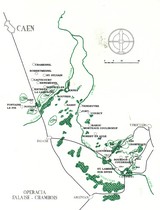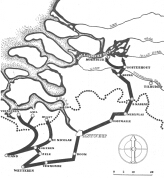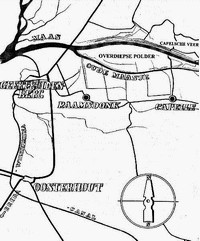NORMANDY
The disembarkation took place in the artificial harbour near Arromanches in Normandy and on the 1st of August the Regiment was assembled on the French soil.
The Regiment's fighting record on the Continent is the subject of a booklet entitled: "The 1st Armoured Regiment in action from Caen to Wilhelmshaven", which appeared on the first anniversary of the Regimental Day, the 19th August 1945. Library Generaal Maczek Museum 880971. For this reason there will be only a short outline given here.

click on map to enlarge
The entry of the Regiment into actual fighting took place the 8th August 1944, south-east of Caen, when the 1st Polish Armoured Division was ordered to hammer the strongly defended German lines in front of Falaise.
The Regiment took part for a fortnight in a heavy and bloody struggle, having many successes but also suffering heavy losses.
The most memorable days in that period were:
- 9th August when the Regiment in a sharp attack broke the strong German defences by the river Laison and reached the hill 111;
- 15th August when the Regiment took part in the Jort, forcing of the river Dives near Jort;
- 19th, 20th and 21st August - days of fierce battles, for the holding of the hill 262, so called "The Mace", and ending by the utter destruction of German forces in the "Falaise pocket".
That hill was the witness of a very bloody battle, where the soldiers of the Division took revenge on the Germans. The seizing and holding of "The Mace" was very important, for it denied the roads of retreat from north-east to the Germans trapped in the "Falaise pocket". That's why the three days' battle was a life and death struggle.
The Regiment had to beat off fierce attacks of German infantry and tanks belonging to the elite of German armoured divisions : the 1st SS and the 12th SS. The battle ended with the complete
defeat of the enemy: hill 262 and the roads leading to it were covered with German dead and hundreds of shattered enemy vehicles, tanks and guns piled up and burned out.
The day of 19th August, being the seizing of hill 262 by the 1st Armoured Regiment has become the Regimental Day.
ACROSS FRANCE
After a few days' rest the Regiment participated in the pursuit of the fleeing enemy.

click on map to enlarge
In its advance, in contact with German rear-guards, the Regiment fought for the crossing of the river Somme below Abbeville, then fought its way through to the canal Neuf Fosse to enter Belgium on the 6th September.
BELGIUM
That same day, bypassing the town of Ypres, it cut off the retreat of the Germans still bolding that town. Next 2 days were spent in the fighting for the town of Roulers, then the Regiment went into action around Ruysselede, after bypassing the town of Thielt.

click on map to enlarge
As a result of this action it advanced 524 km. In 12 days, destroying many German columns and centres of resistance and taking large numbers of prisoners.
Next week the Regiment fought around the town of St. Nicolas which it entered on tbe 12th September. It captured the town of Stekene, then it went into Holland taking part in the capture of tbe town of Axel and reaching the mouth of the river Scalde.
After that, the Regiment moved for a few days' rest to St. Gilles, near St. Nicolas, among the very friendly Flemish population. During few days' stay in St. Nicolas the Regiment was made very welcome by the population which, one year and a half later (3rd March 1946) presented it with Colours.
HOLLAND
The 28th September the Regiment went into action again, east of Antwerp, where with units of the 3rd Infantry Brigade it fought heavily for 5 days for the capture of Baarle-Nassau and Alphen. The odds were heavy, the country heavily wooded and mined, and defended with numerous anti-tank guns and strong artillery.

click on map to enlarge
After the capture of Alphen there was a temporary stalemate and the Regiment consolidated the recently won territory for 3 weeks and started the action on the 27th October for the capture of Breda which was taken after 8 days' battle. A short rest in the liberated town and then the Regiment was given the task of capturing the town of Made which task it accomplished.
The reaching of the river Maas was the final stage of the offensive which was followed by a period of 5 months' defence along that river (from 9th November 1944 until 7th April 1945).

click on map to enlarge
In that period the Regiment stayed respectively in Wagenberg, Oosterhout, Dongen, Udenhout, then in January and February took up positions on the peninsula of St.Philipsland and the island of Tholen where the enemy was rather active.
At the end of February the Regiment returned to the district Dongen - Oosterhout where the tank crews held the advanced posts. This whole period was characterised by frequent moves and minor actions, not without losses.
To complete the description ol that period, one has to mention the flying bombs which accompanied the men day and night during those months, flew over their heads and sometimes exploded uncomfortably near. There were thousands of them and their noisy presence became inseparable from the landscape and the atmosphere of these days.
GERMANY

click on map to enlarge
The 7th April 1945 the Regiment commenced a new action which partially fulfilled its hopes: the Regiment stood on German soil. It left Dongen the 7th April and after 34 hours march - covered the distance of 240 km., crossing the Rhine at Rees.
The 14th April the Regiment took over from the Canadians in front of the strongly defended Küsten Kanal. After the forcing of the Canal by other units of the Division, the Regiment launched an attack for the capture of the town of Aschendorf which it reached the 20th April after having had to overcome many ground obstacles, defended by anti-tank guns.
For the next 2 days the Regiment fought north of the town of Papenburg and seized the important communication center of Ihrhove-Ihren.
A week afterwards it crossed the river Leda to open the road for the 3rd Infantry Brigade.
It passed Leer, Loga, Filsum, Hesel, Moorburg, overcame obstacles and demolitions and captured the village of Halsbek. Here the order of "cease fire" was given the 5sth May at 08.00 hours. Germany had capitulated on the whole front.
Next morning the Regiment went north to Clevern, passing by German columns which were assembling in ordered places.
On the 8th May the Regiment moved to Wittmund, 25 km. West of Wilhelmshaven. The fighting tasks had ended and the occupation ones had begun.
During the 9 months' campaign - from Caen to Wilhelmshaven - the Regiment inflicted the following losses on the enemy:
destroyed 15 tanks type "Tiger", "Panther" and "Mark 1V"
5 self propelled guns
90 anti-tank guns cal. 75, 76 and 88 mm.
taken prisoners 22 officers and 2563 other ranks
The losses suffered in that time by the Regiment:
killed: 10 officers and 46 other ranks
wounded: 26 officers and 121 other ranks
missing: 5 other ranks
The total : 208 soldiers
Our losses in equipment were:
43 "Sherman" tanks destroyed by anti-tank guns
10 "Sherman" tanks destroyed by anti-tank mines
The total 53 tanks
|